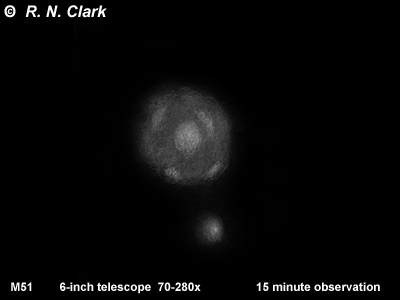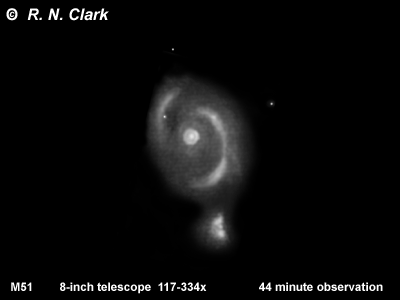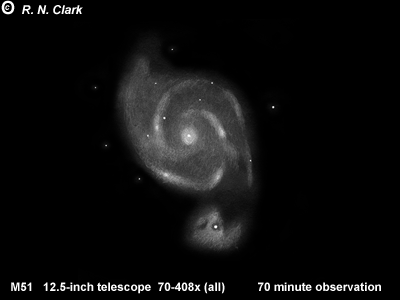ClarkVision.com
| Home | Galleries | Articles | Reviews | Best Gear | Science | New | About | Contact |
| Home | Galleries | Articles | Reviews | Best Gear | Science | New | About | Contact |
Introduction
Telescope aperture has a large influence on the detail you can see in faint objects viewed through your telescope. This is a well known fact, but this series illustrates the effect. For each aperture, below, a range of magnifications were tried in order to see as much detail as possible ( see the effect of magnification ). All observations were done under dark country skies in the mountains of Colorado.
Figure 1 shows a small telescope (6-inch aperture) view of the galaxy M51. While the spiral structure of M51 is apparent, no detail in the spiral arms can be seen.
 Figure 1.
M51 viewed through a 6-inch aperture telescope.
Figure 1.
M51 viewed through a 6-inch aperture telescope.
Increasing the aperture by 2-inches to 8-inches, considerably more detail on the spiral arms is visible.
 Figure 2.
M51 viewed through a 8-inch aperture telescope.
Figure 2.
M51 viewed through a 8-inch aperture telescope.
Increasing the aperture to 12 inches, smaller detail in the spiral arms becomes apparent.
 Figure 3.
M51 viewed through a 12.5-inch aperture telescope.
Figure 3.
M51 viewed through a 12.5-inch aperture telescope.
If we put the views from observations at all telescope apertures together into one animated gif (Figure 4), we can see how the detail changes with aperture.
 Figure 4. 6, 8, and 12.5 inch telescope
drawing together in an animated gif.
Figure 4. 6, 8, and 12.5 inch telescope
drawing together in an animated gif.
For more technical discussion of the magnification effects, see:
the Optimum Magnified Visual Angle (OMVA), for detecting the smallest, lowest contrast objects or detail within objects viewed through a telescope. Recent research and discussion about the concept, the confusion and controversies concerning the OMVA.
| Home | Galleries | Articles | Reviews | Best Gear | Science | New | About | Contact |
This page URL: http://www.clarkvision.com/articles/visastro/m51-apert
Visual Astronomy main page at ClarkVision
Last updated April 9, 2002